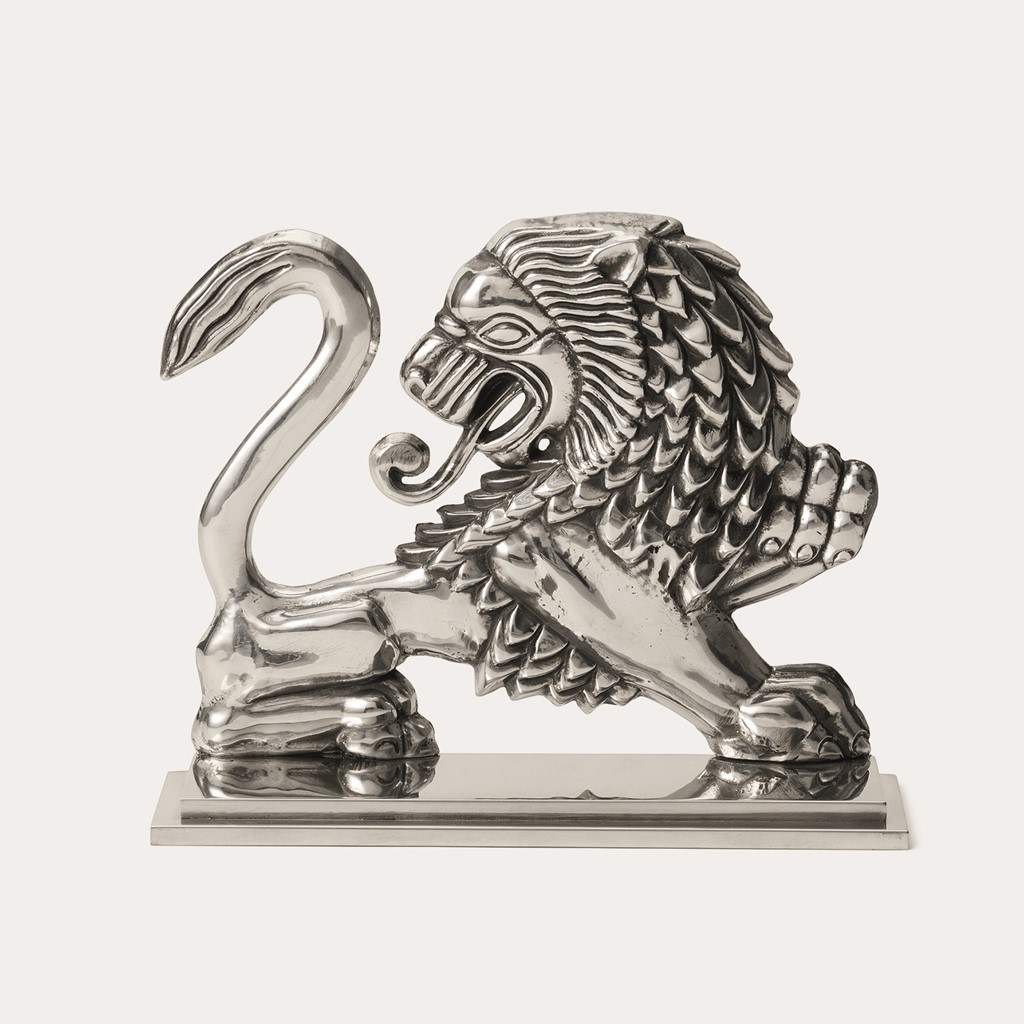
A Legacy of SWEDISH MODERN
25 January 2017
Fanny Siltberg
The story of Svenskt Tenn is a long and winding one, as colourful as a Josef Frank pattern and as rich in inspiration and effort as the most finely crafted pewter lion. It begins in small Hjo in the middle of Sweden and winds its way through Vienna and Paris, via the United States, to Strandvägen 5A in Stockholm. The interior design shop has become a destination of pilgrimage for some, and the definition of classic taste for many. The LINK met up with Svenskt Tenn to find out what has kept them at the heart of the Swedish design scene for over 90 years.
It’s 1975 and Estrid Ericson is getting older. Not necessarily more tired, but older. The 81-year old designer and entrepreneur is trying to figure out what to do with her beloved company and life’s work, Svenskt Tenn. By now, the small pewter workshop that she started in 1924 has grown into a colourful flagship store on Strandvägen in Stockholm. The large and loyal clientele can’t get enough of the handcrafted pewter decorations and interior creations, not to mention Josef Frank’s exquisite furniture designs and colourful patterns. Svenskt Tenn has already become somewhat of an institution, the front runner of “Swedish Modern”, and Ericson is determined to keep it that way. But she has no children, and Josef Frank, her lifelong collaborator, had passed away a couple of years earlier with no one left behind to carry on his craft. As luck would have it, the solution came in the form of Kjell and Märta Beijer’s Foundation. At the end of 1975, Ericson sold the company to the Foundation on one condition; that they would strive to carry on the company’s legacy forever.
Forty years later, Thommy Bindefeld, the current Marketing Director at Svenskt Tenn, describes this as one of the defining moments in the company’s history.
“When Ericson sold the company to the Foundation, that was the best thing she could do for the future of Svenskt Tenn,” he tells The LINK.
Today, Svenskt Tenn is a flourishing company, firmly established on the Swedish interior design scene. The fact that the owner is a foundation enables Bindefeld and his colleagues to take the company into the future at a pace that preserves the legacy Ericson was so keen on keeping.
“There is no private owner wanting to make a profit out of the foundation and its aim is to secure the company for the future. Of course we need money to run it, but everything that we earn on top of that goes to research in medicine and ecology via the foundation,” Bindefeld explains.
In the last 20 years, those earnings have not been disappointing. During that time, almost 150 million SEK has been raised to the Beijer Institute of Research via Svenskt Tenn. And so, what started as an entrepreneurial notion in the 1920s, will now benefit generations to come.
HISTORY
Estrid Ericson was born in Öregrund in 1894 and grew up in Hjo, a small town outside of Skövde. In the late 1910s, she moved to Stockholm to study to become an art teacher at what is today Konstfack (University College of Arts, Craft and Design). But Ericson’s ambitions went further than that and in 1924 she started a small pewter workshop together with her friend Nils Fougstedt. Using a small inheritance from her father, the partners could set up shop shortly thereafter and at the end of the year, the Svenskt Tenn store opened its doors to customers for the first time. According to the Röhsska Museum in Gothenburg, who specializes in Swedish craft history, the timing couldn’t have been better. The design ideals at the time were rapidly shifting towards more pragmatic and strict aesthetics. As a result, pewter saw a revival as a material since it was seen as a more “honest” alternative to electroplated nickel silver, which had been popular until this point.
The success of the shop was instant, and quickly recognised internationally. At the International Exhibition of Modern Decorative and Industrial Arts in Paris in 1925, Ericson and Fougstedt were awarded a gold medal for their designs. The prize led to further opportunities back home and soon, Svenskt Tenn could expand and hire more designers. It was the starting point of the long-lasting tradition of tying skilled craftsmen to the company. A little over five years after its inception, Svenskt Tenn had gone from a two-man pewter workshop, to an interior design shop with 35 employees. In 1927, Svenskt Tenn had outgrown its initial premises and the shop was moved to its now famous address; Strandvägen 5A.
In the 1930s, Ericson reached out to the man who was to become the most influential and productive collaborator to Svenskt Tenn of all time. Josef Frank was an Austrian architect and designer who had caught her attention early on. Once he started working with Svenskt Tenn, its offerings widened to not only cover pewter, but furniture and whole interior settings too. Frank moved to Sweden in 1933 together with his Swedish wife. His contribution in terms of furniture designs, patterns and lamp constructions makes up a huge part of Svenskt Tenn’s offering to this day, and his name is closely connected to the brand. Not least in the form of his colourful and intense patterns, which many associate with his name. Throughout his time with Svenskt Tenn, he produced nearly 200 unique patterns, and to Bindefeld, these are somewhat of a treasure to have in the archive. He is amazed by how timeless Frank’s designs are, and how it is hard to tell if they were designed in the 30s or last year. His own personal favourite, is the print “Miracle”.
“It is one of Josef Frank’s best prints. I think that was his own opinion as well because he has said somewhere that it was miracle that he could repeat the pattern so seamlessly. He had an extremely architectural way of doing the repeat, how the print runs. When you look at Miracle, you can’t see where the repeat begins or where it ends - he has done it in such a subtle way,” Bindefeld explains.
Mirakel by Josef Frank
Together, Frank and Ericson steered the company with a strong sense of integrity for decades. Today, if you buy something at Svenskt Tenn, it is practically guaranteed that you will return home with something generally perceived as being of a classic taste. That correlation however, hasn’t always been a given. Röhsska Museum explains that it is quite extraordinary how two people who often broke the norms around them, became the precept for good taste. In their creations, they were often at odds with the prevailing design ideals. Between the 1930s and 1950s for example, functionalism dominated the Swedish design scene. Practicality was of the essence and any abundant decoration or extravagances in interior design were to be avoided. Frank and Ericson on the other hand, had a more individualistic and emotional view of the home. And so, colourful patterns were mixed with classic furniture, cheap artefacts from Ericson’s many travels were mixed with precious materials and the interior setup was allowed to carry meanings, moods and tell stories. In 1958, Frank coined the expression “accidentism”. He meant that the city, the house and the home should indeed be carefully planned, but look almost as if they came to be by accident. This ideal shines through in everything that Svenskt Tenn does and at the time, it was a sore point for the establishment.
WHAT A DIFFERENCE A DECADE MAKES
After having sold the company, Estrid still played an active part in it for many years, but passed on the title of CEO to Ann Wall in 1979. Wall had studied graphic design and marketing and under her leadership, the company entered a new era. The company took on a contemporary form and slowly but surely, the business grew to new heights. Because for all the fame and good reputation the company had at the time, it still didn’t show much profit. Through new collaborations and strategies, Wall eventually turned the bottom line from red to black.
“Ann Wall put on exhibitions, she collaborated with new contemporary designers and she relaunched and launched designs that Josef Frank had done that had not been in production earlier. She gave the company a fresh start,” Bindefeld explains.
He goes on to explain how Svenskt Tenn today has taken the best from the two different styles of leadership and continue to build on the heritage of both. It is a balance between maintaining the historical part from Estrid Ericson and her strong sense of entrepreneurship, while still maintaining the level of business mindedness that Ann Wall brought to the company. He calls it a commercial cultural institution.
“We have both culture and heritage. We manage an important part of Swedish design history but we are also commercial, so we always balance between being cultural and contemporary and between historical and contemporary. Because if we would only be historical and cultural we might as well be a museum,” he says.
MAINTAINING A LEGACY
The connection between Svenskt Tenn and the Swedish craft scene has always been strong. The lion’s share of Svenskt Tenn’s current product offering is designed and produced in Sweden by small companies dealing with glass and pewter manufacturing, carpentry and weaving. To say that Svenskt Tenn and their suppliers go way back, would almost be an understatement.
“Most of them have worked with Svenskt Tenn for generations. Many are third or second generation craftsmen that work with us and their fathers or grandfathers worked directly with Josef Frank. Or with Ericson of course,” Bindefeld tells The LINK.
To Bindefeld, encouraging and supporting Swedish craftsmen and women, is important. To him, it is a sad state of affairs that a lot of the Swedish craft skill that used to exist, has already been lost. He sees Svenskt Tenn as a counter weight to that trend.
“We try as hard as we can to support our suppliers and to give them orders in order for them to exist for their next generation. Some of them have next generation working, but it is a hard climate to be in,” he says.
In addition to collaborating with local craftsmen, Svenskt Tenn also tries to promote the Swedish craft scene in other ways, says Bindefeld. A couple of months ago, they put on a big exhibition in the store, showing the visitors five different craft workshops live in action. Together, they make up a quarter of Svenskt Tenn’s entire production.
“We talk about locally produced food. This is locally produced design and I think the interest for that is growing. I think that the generation who is interested in locally produced food is also interested in locally produced design. The aim with this exhibition is also for people to realise that there is a craft tradition in Sweden at all,” says Bindefeld.
When asked to summarise the essence of Svenskt Tenn, Bindefeld describes it as a multi faceted diamond. It is a nod to the many factors that he believes have kept the company going for so long; its strong ties to the Swedish craft scene, the fruitful collaboration between Estrid Ericsson and Josef Frank, and the continuous partnerships with contemporary designers. It has proven to be a hotbed for long term success, ensuring that the products never feel outdated. And for the foreseeable future, changing location will not be an option either. Bindefeld is certain that having one shop as the only outlet, is part of Svenskt Tenn’s charm.
“We have no plans to open anywhere else. Some time ago, a magazine wrote that the best thing about Svenskt Tenn is that you have to make a pilgrimage to Stockholm to see it. That’s a good way to put it. We are a diamond but we like to keep things small and secret as well.”
Perhaps not the most well hidden of gems, but a diamond none the less, Svenskt Tenn has managed to build an institution around the subtle balance between being timeless and contemporary all at the same time.



